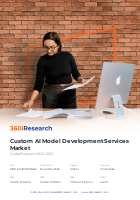
Custom AI Model Development Services Market by Model Type (Computer Vision Model, Large Language Model, Multimodal Model), Service Type (Advisory & Roadmapping, Data Services, Deployment), Engagement Model, Data Modality, Pricing Model, Integration Level, Use Case, End-User Industry, Deployment Type, Organization Size - Global Forecast 2025-2032
SKU
MRR-E9410937B2AE
Region
Global
Publication Date
November 2025
Delivery
Immediate
2024
USD 16.01 billion
2025
USD 18.13 billion
2032
USD 45.75 billion
CAGR
14.01%

Download a Free PDF
Get a sneak peek into the valuable insights and in-depth analysis featured in our comprehensive custom ai model development services market report. Download now to stay ahead in the industry! Need more tailored information? Ketan is here to help you find exactly what you need.



